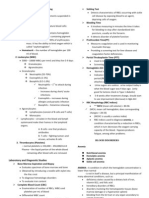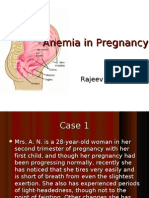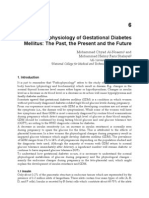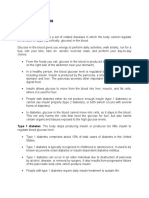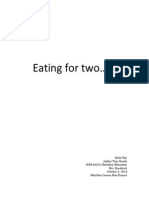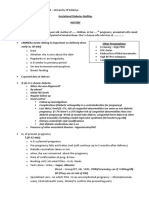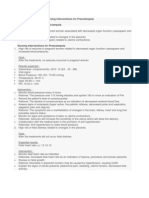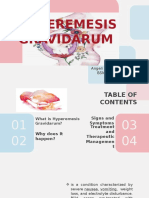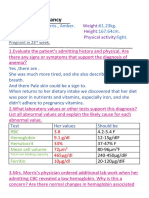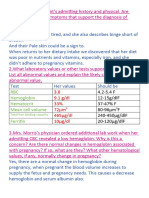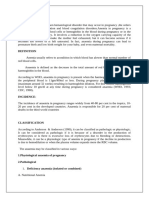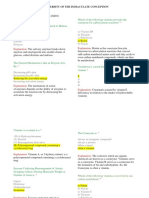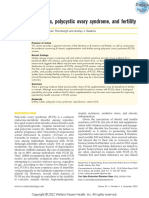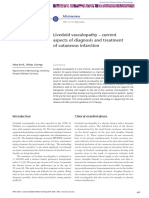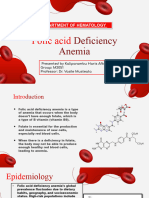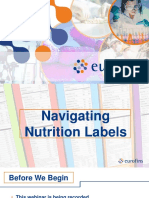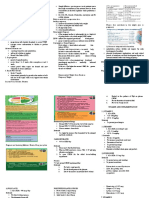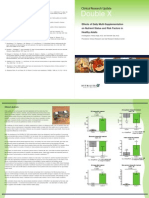MNT I Case Study 1 Anemia in Pregnancy - Xhou
MNT I Case Study 1 Anemia in Pregnancy - Xhou
Uploaded by
api-254534492Copyright:
Available Formats
MNT I Case Study 1 Anemia in Pregnancy - Xhou
MNT I Case Study 1 Anemia in Pregnancy - Xhou
Uploaded by
api-254534492Original Title
Copyright
Available Formats
Share this document
Did you find this document useful?
Is this content inappropriate?
Copyright:
Available Formats
MNT I Case Study 1 Anemia in Pregnancy - Xhou
MNT I Case Study 1 Anemia in Pregnancy - Xhou
Uploaded by
api-254534492Copyright:
Available Formats
MNT Case Study 1: Anemia in Pregnancy
Group 9: Pumpkins
I: Understanding the Diagnosis and Pathophysiology:
1) Evaluate the patients admitting history and physical. Are there any signs or symptoms that
support the diagnosis of anemia?
Yes, the patient has a few signs and symptoms that support the diagnosis of anemia. Some elements
of the patients admitting history and physical that match up with signs of anemia are tiredness/fatigue, pale
skin, pale sclera/light pink lower eyelid, and shortness of breath.1 Some of Mrs. Morris lab results also support
the diagnosis of anemia, specifically, her low hemoglobin and hematocrit levels, low MCV, low ferritin, and high
TIBC.2,3
2) What laboratory values or other tests support this diagnosis? List all abnormal values and
explain the likely cause for each abnormal value.
There were many lab values to support the diagnosis of anemia. After reviewing the patients laboratory
results, we found that many of her hematology values were abnormal. Below is a chart detailing the abnormal
hematology, Mrs. Morriss exact lab values for the certain hematologic terms, and the causes that are likely to
explain the patients abnormal lab results.
Table 1
Summary of patients abnormal lab valuesa
Abnormal
Hematology
Patient Labs
RBC
3.8 x 106/mm3
Hgb
9.1 g/dL
MCV
72 m3
Explanation of Likely Cause(s)
Anemia is defined as a deficiency of RBCs so
this would explain why the red blood cell count
is lower than the average for females. The
type of anemia Mrs. Morris was diagnosed
with was most likely an iron-deficiency anemia
which could be the result of her diet and/or
recent loss of blood.
Hemoglobin is low because it is the oxygencarrying pigment of the RBCs. Thus, since the
RBCs are low, these conjugated proteins will
be low as well.
The mean corpuscular volume measures the
average volume size of red blood cells and in
this case it is lower than normal because it
reflects the high number of small red blood
cells in the patients blood.4 Microcytic RBCs
are a sign of advanced iron deficiency and
suggest a long duration of iron deprivation.
MNT Case Study 1: Anemia in Pregnancy
TIBC
465 g/dL
Ferritin
10 g/dL
Folate
2 ng/dL
Hct
33%
Group 9: Pumpkins
The total iron binding capacity is increased
because the low iron status means there is an
increased capacity of transferrin to become
saturated with iron.
Ferritin levels are decreased because there is
less of a need for the body to store iron if there
is low iron. Ferritin levels reflect the bodys
iron stores, so if the iron stores are low ferritin
will have a decreased lab value.
It is common for folate levels to drop during
pregnancy. Women need more folate when
pregnant in order to support fetal and
placental growth, including creating new RBCs
and synthesizing DNA. In Mrs. Morris' case,
this may also be related to the poor quality of
her diet and inconsistent adherence to taking
prenatal vitamins.
The volume percentage of erythrocytes will be
decreased simply due to the fact that the
number of erythrocytes are decreased when
someone has anemia.
Adapted from references 3 and 4.
3) Mrs. Morriss physician ordered additional lab work when her admitting CBC revealed a low
hemoglobin. Why is this a concern? Are there normal changes in hemoglobin associated with
pregnancy? If so, what are they? What other hematological values, if any, normally change in
pregnancy?
A low hemoglobin level is a concern, especially because Mrs. Morris is pregnant. It is one symptom of
anemia, and being anemic during pregnancy can potentially cause the fetus to become anemic later in
pregnancy. Other concerning factorswhich are common outcomes of anemic mothersare preterm delivery,
low birth weight, and developmental defects. In addition, anemia can cause the mother to have an increased
blood loss during her pregnancy, making it more difficult for her to fight infections.1 There is a normal decrease
in hemoglobin associated with pregnancy. Not only do the hemoglobin levels drop but the hematocrit levels
also drop during the first and second trimester because of the expansion in blood volume. In fact there are
many hematological values that normally change in pregnancy. Increased values during pregnancy include
erythropoietin, mean corpuscular hemoglobin (MCH), MCV, white blood cell (WBC) count, neutrophils, and
transferrin.5 There are also many decreasing hematological values such as ferritin, folate, RBC, and red cell
distribution width (RDW).5 Yet, the recommended RDA intake of iron increases from 18 mg for non-pregnant
women to 27 mg in pregnancy, causing many pregnant women to have some degree of an iron-deficiency.5,6
MNT Case Study 1: Anemia in Pregnancy
Group 9: Pumpkins
4) There are several classifications of anemia. Define each of the following: megaloblastic anemia,
pernicious anemia, normocytic anemia, microcytic anemia, sickle cell anemia, and hemolytic
anemia.
Megaloblastic anemia occurs when DNA synthesis of the RBCs is inhibited. This leads to
continuation of cell grow growth without division occurring and results in the presence of large,
immature, abnormal, RBC progenitors in the bone marrow.3
Pernicious anemia frequently occurs from a lack of intrinsic factor, which is a glycoprotein in gastric
juice that is essential in the absorption of vitamin B12. Without proper absorption, a vitamin B12
deficiency can occur and result in pernicious anemia. This type of anemia is chronic and
macrocytic.3
Normocytic anemia is characterized by red blood cells that are of average size (MCV 82-92) but
have decreased hematocrit and hemoglobin levels (MCHC > 30).3
Microcytic anemia is marked by abnormally small red blood cells and less circulating hemoglobin.3
Sickle cell anemia is a recessive disorder that causes defective globin genes in hemoglobin. This
results in RBCs that are shaped abnormally and can easily be caught in capillaries and do not carry
oxygen well.3
Hemolytic anemia is caused by shortened survival of mature red blood cells and the inability of the
bone marrow to compensate for the decreased life span.3
5) What is the role of iron in the body? Are there additional functions of iron during fetal
development?
The main role of iron in the body is transferring oxygen throughout the body. Most of the bodys iron is
found in hemoglobin, which binds to oxygen in the blood and carries it from the lungs to the tissues. It is also a
component of myoglobin, which binds to oxygen in the muscles. Iron also plays a role in serum transferring
and certain enzyme activity.3
During fetal development, maternal blood supply greatly increases which leads to an increased demand
for iron. Pregnant women should increase their iron intake by 700 - 800 mg across the duration of their
pregnancy; this extra iron is used for hematopoiesis and to support fetal and placental tissues. If a woman
does not consume enough iron, hemoglobin production could be hindered; this may result in a lack of oxygen
being delivered to the uterus, placenta, and developing fetus. The added stress can result in a variety of
negative consequences such as premature delivery, retarded fetal growth, low birth weight, or poor neonatal
health.3
6) Several stages of iron deficiency actually precede iron-deficiency anemia. Discuss these stages
- including the symptoms - and identify the laboratory values that would be affected during each
stage.
Stage I and II:
Iron stores are low but there is generally no dysfunction. Iron stores are moderately depleted in stage I
due to reduced iron absorption. Stage II is characterized by severely depleted iron stores.
Stage III and IV:
3
MNT Case Study 1: Anemia in Pregnancy
Group 9: Pumpkins
In stage III, inadequate body iron causes dysfunction that is not accompanied by anemia. Negative iron
balance occurs with dysfunction and anemia in stage IV.
Symptoms (dysfunction):
o Fatigue, decreased concentration, slow cognitive and social development in children,
difficulty maintaining body temperature, decrease immune function, increased susceptibility
to bruising and/or infection, glossitis (inflamed tongue), brittle nails, cracks in the sides of the
mouth, an enlarged spleen, shortness of breath, dizziness, headache, and weakness.
o Can lead to irregular heartbeats (arrhythmias), heart murmurs, an enlarged heart, or even
heart failure.
Table 2
Summary of laboratory values affected by IDAab
Laboratory
Values
Normal
Stage I
Early
negative iron
balance
Stage II
Iron depletion
Stage III
Damaged
metabolism:
iron-deficient
erythropoiesis
Stage IV
Clinical damage:
iron deficiency
anemia
RE marrow Fe
2-3+
0-1+
Transferrin IBC
(mcg/100ml)
300-360
300-360
360
390
410
Plasma ferritin
(mcg/L)
40-160
<25
20
10
<10
Iron absorption (%)
5-10
10-15
10-15
10-20
10-20
Plasma iron
(mcg/100 ml)
65-165
<120
115
<60
<40
Transferrin
saturation (%)
20-50
30
30
<15
<15
Sideroblasts (%)
40-60
40-60
40-60
<10
<10
RBC
protoporphyrin
30
30
30
100
200
Erythrocytes
Normal
Normal
Normal
Normal
Microcytic/
hypochromic
Serum transferrin
receptors
Normal
Normal-high
High
Very high
Very high
Normal-low
Low
Very low
Very low
Ferritin-iron (ng/ml) Normal
a
b
Adapted from references 3 and 10.
Red bolded text formatting used to highlight some of the most important laboratory values characteristic of each stage.
MNT Case Study 1: Anemia in Pregnancy
Group 9: Pumpkins
7) What potential risk factor(s) for the development of iron-deficiency anemia can you identify from
Mrs. Morriss history?
Mrs. Morris has several risk factors which increase her risk of developing IDA. Pregnant women
experience natural physiological changes that affect hematological parameters. While red blood cell mass
increases by about 30%, plasma volume expands by approximately 50%. This creates a dilution effect in
which hemoglobin, ferritin, and RBC become less concentrated within a larger volume of plasma.7
Although it is normal for these lab values to decrease due to pregnancy, it should still be considered a
risk factor. For females 20-49 years old there is a 9% prevalence rate of iron deficiency.8 The WHO estimates
that 18% of pregnant women in industrialized countries are anemic, and that 12% of non-pregnant women
have anemia.9 Considering this, females who are iron deficient before pregnancy are at increased risk of IDA
because not only will they not have enough iron stores to meet pre-pregnancy needs, but the RDA rises
sharply from 18 mg/day to 27 mg/day. Thus, it may be more difficult for women at risk to accumulate the
necessary iron stores to prevent IDA, let alone meet pregnancy needs. Mrs. Morriss hemoglobin value still
indicates IDA (9.1 g/dL Hgb compared to <10.8 g/dL for ~24 weeks gestation and smoker status according to
CDC gestational age-specific cutoffs) despite a lowered diagnostic criteria for pregnant women.7
Mrs. Morris drinks coffee or tea with every meal. Tannins from these beverages form insoluble
complexes with iron, decreasing absorption up to 50%.7 Also, Mrs. Morris doesnt take her prenatal
multivitamins consistently, which would help resolve any iron deficiency that existed before the pregnancy plus
supplement her diet to meet the increased demands of iron on pregnancy.
Her food intake is low, which compounds the ability to meet the increased nutrient needs of pregnancy,
including iron.10 The presence of nausea during her first trimester would indicate that some of the nutrients
from what she consumed were not being absorbed. Shes only gained 7 lb by the 23rd week -- according to
pregnancy weight gain guidelines recommendations, Mrs. Morris should have gained 11 lb to 18.7 lb by this
time.11 Falling short of this guideline is evidence for inadequate energy intake and possibly inadequate nutrient
intake.
Calculations for Pregnancy Weight Gain Guidelines:
**We used the range of 2.2-6.6 lb in the 1st trimester plus 0.8-1.1 lb/week in 2nd and 3rd trimester, as
recommended for women with a normal pre-pregnancy BMI**
Range of weight gain = [2.2 lb (for 1st 12 weeks) + 0.8 lb/week (11 weeks)] to [6.6 lb (initial 12 weeks)
+ 1.1 lb/week (11 weeks)] = 11-18.7 lb
Mrs. Morris also smokes 1-2 cigarettes a day. Tobacco smoking affects overall nutrition status but
within this case study, its impact on Vitamin C status is particularly important. Owing to her pregnancy and
smoker status, Mrs. Morris has a RDA of 120 mg/day.12 Meanwhile, Mrs. Morris is only ingesting 34 mg
Vitamin C/day according to nutrient analysis of her 24-hour recall using Nutritionist Pro Diet Analysis software
(Axxya Systems, LLC). Because Vitamin C aids absorption of iron, her impaired Vitamin C status indirectly
affects her ability to meet her iron needs.
MNT Case Study 1: Anemia in Pregnancy
Group 9: Pumpkins
8) What is the relationship between the health of the fetus and maternal iron status? Is there a risk
for the infant if anemia continues?
There is little evidence to support an association between maternal iron status and the iron status of the
fetus. However, the fetus could suffer adverse effects if the IDA is not treated. Children of mothers who had
IDA during pregnancy tend to score lower on tests of intelligence, language, gross motor skills, and attention
when tested at five years old.7 The mechanism for this is not yet understood but could be related to oxygen
delivery to the developing brain. Additionally, a fetus accumulates an iron supply for the first 6-8 months of life
if the mother is well-nourished.7 Without this iron store, infants have a higher chance of developing IDA
themselves.
If the IDA exists during the first two trimesters and is severe, this can cause the chances of a low-birth
weight or premature birth to rise.1 Consequently, according to the fetal-origins hypothesis of later disease risk,
this puts infants at risk for increased risk of developing chronic diseases later in life such as type 2 diabetes,
obesity, and hypertension to name a few.7 Because the fetuss metabolism was altered in utero in response to
decreased availability of nutrients it may not be able to adjust to an abundant diet later in life.
There are limitations to this hypothesis, however. Although Mrs. Morris is deficient in calories and in a
few nutrients (Vitamin C, iron, folate, etc.) there is not enough research to provide a specific value for calories,
vitamins/minerals, and other dietary factors that are required to minimize (or, that would cause the most risk)
for chronic disease later in life. It is known that iron supplementation does help improve birth weight and that
there an U-shaped relationship between maternal hemoglobin concentrations and birth weight.9
Although little was found in the literature regarding a direct link between smoking and IDA, both factors
are indicated with increased risk of abruptio placentae, a condition where the placenta separates from the
uterine wall before birth.13 Additionally, a direct cause is injury to the abdomen, such as with her recent fall.14
Therefore, her physician may want to monitor her and the fetus for any symptoms.
9
II: Understanding the Nutrition Therapy:
9) Discuss the specific nutritional requirements during pregnancy. Be sure to address all macroand micronutrients that are altered during pregnancy.
During pregnancy, the mother needs additional energy to meet the metabolic needs for pregnancy and
fetal development.3 According the Institute of Medicines 2002 Dietary Reference Intakes (DRIs), pregnant
adult women need about the same amount of energy as nonpregnant adult women during the 1st trimester of
pregnancy, followed by an increase of 340-360 kcal/day in the 2nd trimester and another increase of 112
kcal/day in the 3rd and final trimester.15,16 Since individuals can differ greatly in terms of energy expenditure
including basal metabolic rate (BMR), healthy levels of energy intake for pregnant women can vary widely as
long as maternal weight gain is WNL of about 0.4 kg (14 oz.) per week during the final 30 weeks of
pregnancy.3
Pregnant women need to take in more protein than nonpregnant women in order to form both new
tissues for both the mother and fetus. This requirement continues to grow during gestation and is the highest
during the 3rd trimester.3 During the 1st half of pregnancy, the protein requirement remains the same as for
nonpregnant women at 0.8 g/kg/day.3 In the 2nd half of pregnancy, however, the protein requirement
increases to about 1.1 g/kg/day based on prepregnancy weight. This is about 71 g/day for most pregnant
women.3
6
MNT Case Study 1: Anemia in Pregnancy
Group 9: Pumpkins
The mothers blood supply increases significantly during pregnancy, which results in concomitant
increase in the amount of iron consumption required for a healthy pregnancy (to create blood cells as well as
for placental and fetal tissues). The Nutrition Care Manual recommends that pregnant women increase iron
consumption from 18 to 27 mg per day.10 Insufficient iron may lead to poor Hgb production and subsequently
to the uterus, placenta, and fetus not receiving enough oxygen as well as maternal anemia potentially resulting
in premature delivery, growth retardation of the fetus, or low birth weight (LBW).3
In a healthy pregnancy, a variety of hormones interact so that more calcium is absorbed and retained in
order to meet demands for the development of the fetal skeletal system.3 At least 3 cups of low-fat dairy per
day is recommended for pregnant women.10 However, this does not differ significantly from the AI of calcium
for nonpregnant women, which is 1,000 mg.15
Sufficient intake of zinc is very important to a healthy pregnancy, partly because the zinc in the
mothers skeleton is not easily freed in times of deficiency. During pregnancy, the DRI for zinc increases from 8
to 11 mg per day.15
Zinc deficiency carries serious consequences including congenital malformations and abnormal fetal brain
development.3 Zinc is an essential mineral that is essential for many functions including protein synthesis,
nucleic acid metabolism, and cell division. Healthy maternal zinc concentrations are needed to maintain
sufficient placental transport and supply of zinc to the fetus. Zinc deficiency may contribute to premature birth
via hormonal changes as well as increased risk of systemic and intra-uterine infections.17
Pregnant women need more folate to support the growth of the fetus and placenta as well as for
creating new red blood cells (erythropoiesis) and synthesizing DNA. Folate deficiency in pregnant women is
associated with increased risk of congenital malformations in the child, including cleft lip and neural tube
defects.3 The DRI for folate increases from 400 to 600 g of dietary folate equivalents per day for pregnant
women.15
The DRI of vitamin B12 is increased from 2.4 to 2.6 g per day during pregnancy.15 Vitamin B12 is
essential for for proper red blood cell formation, neurological function, and DNA synthesis.18 Without vitamin
B12, methionine and tetrahydrofolate (THF) cannot be produced.3 Vitamin B12 crosses the placenta and is
important for fetal brain development.3,18 Vitamin B12 deficiency during pregnancy may impair the cognitive
and motor development of the child later as an infant.3
The daily requirement for vitamin C increases from 75 to 85 mg during pregnancy.15 Vitamin C is
needed for synthesizing collagen as well as its antioxidant functions.3
Table 3
DRIs for nonpregnant vs. pregnant adult womena
NUTRIENT
ADULT WOMEN
PREGNANCY
Energy (kcal)
2,403
2,403 (1st trimester)
2,743 (2nd trimester)
2,855 (3rd trimester)
Protein (g/kg)
0.8
0.8 (1st half of pregnancy)
1.1 (2nd half of pregnancy
calculated using prepregnancy
weight)
Iron (mg)
18
27
7
MNT Case Study 1: Anemia in Pregnancy
Group 9: Pumpkins
Calcium (mg)
1,000
1,000
Zinc (mg)
11
Folate (g dietary
folate equivalents)
400
600
Vitamin B12 (g)
2.4
2.6
Vitamin C (mg)
75
85
Adapted from references 3, 10, and 15.
10) What are best dietary sources of iron? Describe the differences between heme and nonheme
iron.
Many of the foods that contain the most iron per serving are plant-based, specifically cereals and
legumes (e.g., ready-to-eat 100% iron-fortified cereal, instant grits, instant oatmeal, cooked soybeans, and
canned white beans contain 18 mg, 7.1 mg, 5 mg, 4.4 mg, and 3.9 mg of iron per serving, respectively).10
However, it is primarily animal foods that contain heme iron (found in hemoglobin, myoglobin, and certain
enzymes). The heme form of iron is bound to protoporphyrin IX and is more bioavailable than the nonheme
form of iron in plant and fortified foods.10 The bioavailability of heme iron is not only greater than that of
nonheme iron, but it is also more stable in the presence of other dietary factors. Moreover, the absorption of
the nonheme iron is enhanced when eaten together with meat or seafood.19 Iron from animal foods (heme and
nonheme) is thus more easily absorbed by the body than iron from plant foods and supplements (nonheme
only). Nevertheless, both plant and animal foods can be good sources of iron. Animal foods that are good
sources of iron include beef and other red meats, liver, seafood, and eggs; and plant foods that are good
sources of iron include bran cereals, enriched breads and cereals, raisins and other dried fruits, cooked beans,
tofu, potatoes with skin, spinach and other leafy greens, and certain nuts (almonds and pistachios).10 Another
way to increase dietary intake of iron is to cook vegetables and/or meats in a cast iron pot or pan, since some
of the iron from the pot or pan will be transferred to the food during the cooking process.
11) Explain the digestion and absorption of dietary iron.
There are a few differences in how heme and nonheme iron is digested and absorbed. Both forms
enter the GI tract via oral intake of iron-containing food. This iron must then be freed from the food via
digestion before it can be absorbed by enterocytes lining the small intestine, primarily in the duodenum.20
Divalent metal transporter 1 (DMT1) transports nonheme iron into enterocytes via facilitated diffusion.3
DMT1 has an affinity for ferrous iron, and the brush border enzyme ferric reductase converts some ferric iron to
ferrous iron. In contrast, heme iron enters enterocytes via vesicles and then enzymes free the iron ions from
the heme.3 Absorbed iron ions from both pathways form ferritin complexes with apoferritin. Iron ions may then
remain stored within the enterocyte as ferritin or be transported to the basolateral membrane.3 There ferrous
iron ions are released to enter the bloodstream via active transport across the membrane. Once in the
bloodstream, the ions are enzymatically oxidized to ferric iron and transported by transferrin throughout the
body.
Changes to the intestinal mucosa affect the efficiency of iron absorption.3 The key hormone that
regulates iron stores and uptake is hepcidin. When body iron stores are excessive, hepcidin downregulates
8
MNT Case Study 1: Anemia in Pregnancy
Group 9: Pumpkins
basolateral release of iron from cells by binding the basolateral iron transporter, ferroportin.21 Thus, hepcidin
inhibits dietary iron absorption. Conversely, in iron deficiency, increased production of erythrocytes, and
hypoxemia upregulate iron transportors in the enterocytes and stimulate increased iron absorption in the
intestines.21
Phytates found in some grains and beans; oxalates found in spinach; and certain polyphenols found in
cereals, legumes, and coffee can also inhibit iron absorption and contribute to lower bioavailability of nonheme
iron from plant foods. Excess consumption of copper, zinc, magnesium, and calcium can also reduce iron
absorption.10 Although heme iron is less susceptible to these dietary factors, calcium may actually reduce the
absorption of both forms of iron.19 Since acid prevents incorporation of nonheme iron into insoluble
complexes, iron absorption increases in the presence of ascorbic acid (vitamin C) and decreases in the
presence of antacids.10 Combining foods high in vitamin C--such as citrus fruits, bell peppers, and broccoli-with dietary sources of iron can enhance nonheme iron absorption to counteract the effect of some of these
absorption-inhibiting substances.
III: Nutrition Assessment:
12) Assess Mrs. Morriss height and weight. Calculate her BMI and % usual body weight.
After assessing Mrs. Morriss height and weight, the following calculations were made:
Pre-pregnancy body weight: 135 lb = 135 lb * 1/2.2 kg/lb = 61.36 kg
Height: 65 = 165.1 cm = 1.651 m
Pre-pregnancy BMI = 61.36/2.726 = 22.5, normal
Current body weight: 142lb = 142lb * 1/2.2 kg/lb = 64.545 kg
Pregnant BMI: 64.545/2.726 = 23.7, normal
% usual body weight = 142/135 x 100 = 105.2%
13) Check Mrs. Morriss prepregnancy weight. Plot her weight gain on the maternal weight gain
curve. Is her weight gain adequate? How does her weight gain compare to the current
recommendations? Was the weight gain from her previous pregnancies WNL?
MNT Case Study 1: Anemia in Pregnancy
Group 9: Pumpkins
No, her weight gain is not adequate. According to the chart above (created using a tool provided by the
Institute of Medicine), she should be closer to the green curve and should have gained about 14 lbs.22 Her
current weight is actually more in line with the range for someone in the pre-pregnancy, overweight range.
Compared to the current Institute of Medicine and National Research Council's guidelines she has not gained
enough weight. The recommended weight gain for someone with a healthy pre-pregnancy weight is 2.2-6.6 lb
in the first 12 weeks, or first trimester, and a gain of 0.8-1.1 lbs per week in the second and third trimesters.11
This means at 23 weeks, Mrs. Morris should have gained anywhere from 11-18.7 lbs, and she has only gained
seven pounds; therefore, she is about 4-11.7 lbs under the suggested requirements.
The weight gain in her previous 2 pregnancies was also not within normal limits. In her first and second
pregnancies she did not gain the recommended weight. She gained 15 lbs in her first and 20 lbs in her second
when she should have gained closer to 25 or 30 lbs.
14) Determine Mrs. Morriss energy and protein requirements. Explain the rationale for the method
you used to calculate these requirements.
According to the IOM 2002 guidelines, Mrs. Morris is significantly under the recommended intake for
protein. Based on her weight, her protein requirements are 67.5 g/day (1.1 g/kg/day x 61.36 kg) and the
nutrient analysis, based on her 24-hour recall, shows that she only consumed 45.5 g, which is a significant
difference of 20 grams.3
According to a 2004 study published in The American Journal of Clinical Nutrition, pregnant women in
the normal BMI range should average an increase of 350 kcal per day in the 2nd trimester, and have an
additional 500 kcal per day in the third trimester.23 Since our patient is in her second trimester of pregnancy,
her energy needs are increased by roughly 350 kcal. Using the Harris-Benedict Equation, we estimated that
her energy needs are 1,674 kcal, based on her height, weight, age and an activity factor of 1.2. Because she is
23 weeks pregnant, an additional 350 calories is added to this total making her total energy requirement
approximately 2,025 kcal/day.
10
MNT Case Study 1: Anemia in Pregnancy
Group 9: Pumpkins
BEE = [655 + (9.6 x 61.36) + (1.8 x 165.1) - (4.7 x 31)] = 1,396 calories x activity factor of 1.2 = 1,674
kcal
**We calculated her normal needs using her pre-pregnancy body weight, and then added in the
recommended calorie intake for pregnant women.
1,674 + 350 = 2,025 kcal/day
15) Using her 24-hour recall, compare her dietary intake to the energy and protein requirements you
calculated in Question 14.
The patients 24-hour recall was analyzed using Nutritionist Pro Diet Analysis software (Axxya Systems,
LLC), and the results were used in the below comparison of her recent dietary intake of energy and protein
PTA to her calculated daily energy and protein needs. A more detailed summary sheet of the analysis results is
attached to the end of this case study.
Table 4
Comparison of patients dietary intake to requirements
Dietary
Needs
Recommendation
Patients Intake
(24-hour recall PTA)
Dietary Intervention
Energy
2,025 kcal/day
1,752 kcal
Energy needs are not being met.
Patient is only consuming 87% of
her recommended caloric intake and
should increase consumption.
Protein
67.5 g/day
46.6 g
Protein needs are not being met.
Patient is only consuming 69% of
her recommended protein intake
and should increase consumption.
16) Again using her 24-hour recall, assess the patients daily iron intake. How does it compare to
the recommendations for this patient (which you provided in question #9)?
Once again the analysis of the patients 24-hour recall was conducted using Nutritionist Pro Diet
Analysis software (Axxya Systems, LLC), and the results were used in the below comparison of her recent
dietary intake of iron PTA to her calculated daily iron needs. Please see the summary sheet mentioned above
for the full analysis.
Table 5
Comparison of patients iron intake to requirements
Dietary
Needs
Recommendation
Patients Intake
(24-hour recall PTA)
Dietary Intervention
11
MNT Case Study 1: Anemia in Pregnancy
Iron
27 mg/day10
19.4 mg
Group 9: Pumpkins
Iron needs are not being met.
Patient is only consuming 72% of
recommended iron intake and
should increase consumption.
IV: Nutrition Diagnosis:
17) Identify the pertinent nutrition problems and the corresponding nutrition diagnoses.
Mrs. Morris has a low caloric intake and thus she is probably not meeting some of her nutrient
requirements, especially given the increased nutrient needs of pregnancy. As evidenced by analysis of her 24hour dietary recall with Nutritionist Pro, her caloric intake, dietary iron, Vitamin C, and folate status are all
below the recommended levels. Her self-reported usual dietary intake also reveals regular consumption of
many processed foods and limited consumption of nutrient-dense fresh fruits and vegetables. Using diagnostic
terminology, her nutrition diagnoses would be inadequate energy intake (NI-1.2-10634); inadequate mineral
intake (iron) (NI-5.10.1-10712); inadequate vitamin intake (Vitamin C) (NI-5.9.1-10680); inadequate vitamin
intake (folate) (NI-5.9.1-10687); and undesirable food choices (NB-1.7-10779).
18) Write a PES statement for each nutrition problem.
Inadequate mineral intake (iron) (NI-5.10.1-10712) r/t increased nutrient needs during pregnancy AEB 19.4 mg
of iron intake according to 24-hour-recall (PTA) relative to the RDA of 27 mg for pregnant women as well as a
low plasma ferritin level of 10 ug/dL, a low hemoglobin level of 9.1 g/dL, and an increased TIBC value of 465
ug/dL.
Inadequate energy intake (NI-1.2-10634) r/t nausea during the first trimester of pregnancy and limited food
preferences AEB pregnancy weight gain that is 7# or 50% short of the recommended weight gain (14#) for
patients pre-pregnancy BMI and length of gestation.
Undesirable food choices (NB-1.7-10779) r/t food- and nutrition-related knowledge deficit AEB 24-hour recall
revealing insufficient dietary intake to meet increased nutrients needs and self-reported usual dietary intake
high in processed foods and low in fresh nutrient-dense foods.
V: Nutrition Intervention:
19) Mrs. Morris was discharged on 40 mg of ferrous sulfate three times daily. Are there potential
side effects from this medication? Are there any drug-nutrient interactions? What instructions
might you give to maximize the benefit of her iron supplementation?
Potential side effects of ferrous sulfate include nausea, epigastric discomfort and distension, heartburn,
diarrhea, and constipation. There are several simple instructions that could maximize the benefit of her iron
supplementation due to some drug-nutrient interactions. Iron is best absorbed on an empty stomach but since
Mrs. Morris has been experiencing GI distress it is recommended that she take them with meals, even if it
decreases the absorption of iron by 50%.24 Another helpful tip would be to consume more vitamin C (citric
fruit), specifically 200 mg vit c/ 30 mg of iron, because it helps compensate this loss of absorption.24 In
12
MNT Case Study 1: Anemia in Pregnancy
Group 9: Pumpkins
addition, she should avoid eating foods high in calcium, phytate, or bran with her iron source because it slows
down iron absorption when these are eaten together.10,19 Lastly, it would be optimal for her to minimize tea
and coffee consumption but if she has to drink tea and coffee it will be best to drink these between meals
rather than with meals so that they do not inhibit iron absorption.10,19
20) Mrs. Morris says she does not take her prenatal vitamin regularly. What nutrients does this
vitamin provide? What recommendations would you make to her regarding her difficulty taking
the vitamin supplement?
Generally, prenatal vitamins contain the following nutrients:25
Folic acid 400 to 800 micrograms
Calcium 250 milligrams
Iron 30 milligrams
Vitamin C 50 milligrams
Zinc 15 milligrams
Copper 2 milligrams
Vitamin B-6 2 milligrams
Vitamin D 400 international units
The main reason reported by the patient for not regularly taking her prenatal vitamins was upset
stomach. To decrease this effect, she should take the vitamin with a small meal or snack to enhance tolerance
and absorption (but separately from the iron supplements for the drug-nutrient interactions explained
previously).10 If she has discomfort when swallowing the pill, breaking the pill in half with a pill splitter and then
swallowing the halves separately and/or taking it with a thicker substance, like yogurt, could help improve her
adherence to taking prenatal vitamins.
Patients may have low adherence to taking pills on time if they have trouble remembering to take the
pills. There are ways to help the patient remember to take her prenatal vitamins. Having a pill box with labeled
compartments for each day of the week could help by organizing the doses for her prenatal vitamins and iron
supplements. Incorporating her vitamin into a daily task could aid in remembering to take it - for instance,
setting them by her alarm clock or by her toothbrush. Keeping them visible, for instance storing the pill box in
her purse, would serve as a visual reminder. Also, her husband could support her by asking whether she has
taken her supplements.
VI: Nutrition Monitoring and Evaluation:
21) List factors that you would monitor to assess her pregnancy, nutritional, and iron status.
Weight gain (AD - 1.1.4)
Calorie intake (FH - 1.1.1.1.)
Measure lab values of plasma ferritin, transferrin, Hgb, TIBC, iron, folate, and vitamin C (BD-1.10.10,
BD-1.10.13, BD-1.10.1, BD-1.10.12, BD-1.10.11, BD-1.10.8, BD-1.13.2)
Assess tolerance of iron supplements and prenatal vitamins, including any continued or worsened
stomach upset.
13
MNT Case Study 1: Anemia in Pregnancy
Group 9: Pumpkins
22) Using the Nutrition Care Process steps, write a chart note using the ADIME format.
Please see the ADIME note on the following page.
14
MNT Case Study 1: Anemia in Pregnancy
Group 9: Pumpkins
Nutrition Care
Progress Note
ASSESSMENT
DIAGNOSIS
INTERVENTION
MONITORING & EVALUATION
31 y.o F w/ gravida 3, para 2
Dxs of: Hypochromic
Microcytic Anemia; 23 week
gestation with normal
ultrasound
Inadequate energy intake (NI1.2-10634) R/T nausea during
the first trimester of pregnancy
and limited food preferences
AEB pregnancy weight gain
that is 7# or 50% short of the
recommended weight gain
(14#) for patients prepregnancy BMI and length of
gestation.
Energy-modified diet (ND 1.2.210830) to increase caloric intake
and increase pregnancy weight
gain to a healthy level.
Monitor for weight gain (AD1.1.4)
Meds: Prenatal vitamins;
ferrous sulfate
Skin: Pale, warm and dry
Eyes: Sclera pale
Lab values (abnormal):
RBC - 3.8 x 106/mm3
Hgb - 9.1 g/dL
MCV - 72 m3
TIBC - 465 g/dL
Ferritin - 10 g/dL
Folate 2 ng/dL
Hct - 33%
Wt: 142# (64.5 kg)
UBW: 135# (61.4 kg)
Ht: 55
IBW: 125#
BMI: 22.5, normal
Inadequate mineral intake
(iron) (NI-5.10.1-10712) R/T
increased nutrient needs
during pregnancy AEB 19.4 mg
of iron intake according to 24hour-recall (PTA) relative to the
RDA of 27 mg for pregnant
women as well as a low
plasma ferritin level of 10
ug/dL, a low hemoglobin level
of 9.1 g/dL, and an increased
TIBC value of 465 ug/dL.
DATE & TIME: 10/14/2014 08:00
Continue taking iron supplements
(ND - 3.2.4 10541) and prenatal
vitamins. Advise pt to take
supplements with food to increase
tolerance and minimize GI upset.
Take iron supplements alongside
foods high in vitamin C to maximize
absorption.
Provide nutrition education r/t
increased nutritional needs during
pregnancy and relationship of
nutrition to maternal and fetal
health/disease (E 1.4-10591).
Monitor her calorie intake (FH1.1.1.1)
Monitor lab values where
available, particularly plasma
ferritin, transferrin, Hgb, TIBC,
MCV, iron, folate, and vitamin C
(BD-1.10; BD-1.13)
Monitor tolerance of and
adherence to taking iron
supplements and prenatal
vitamins, including associated GI
distress.
Provide nutrition education,
specifically skills to select iron-rich
foods (E 2.2-10597).
Referral to community
agencies/programs (WIC) (RC 1.610625).
15
MNT Case Study 1: Anemia in Pregnancy
Diet: NPO
(only while admitted).
Appetite: Self-reported as
good, but does not like many
foods; 24-hour recall of dietary
intake PTA indicated PO
intake of 1,752 kcal, protein
intake of 46.6 g, iron intake of
19.4 mg, and folate intake of
733 g DFE.
Group 9: Pumpkins
Vitamin-modified diet (ND 1.2.910837) to increase vitamin C and
folate consumption.
Mineral-modified diet (ND 1.2.1010838) to increase iron intake so
that she can be weaned off of the
iron supplement.
EEN: 2,025 kcal/day
(HBEx1.2 activity factor+350
kcal for 2nd pregnancy)
67.5 g protein/day
(61.36 kg x 1.1 g/kg/day)
Fluids: 2,000-2,400 mL/day
(specific calculation: 64.545
kg x 35 mL/kg = 2,259 mL)
Signature & Credential: Alainna Baxley, Kelsey Conyers, Xiaolu Hou, and Sarah Liu, (future) RDs
16
MNT Case Study 1: Anemia in Pregnancy
Group 9: Pumpkins
References
1.
2.
3.
4.
5.
6.
7.
8.
9.
10.
11.
12.
13.
14.
15.
16.
17.
18.
19.
20.
21.
22.
23.
24.
25.
American Society of Hematology. Anemia & Pregnancy.
http://www.hematology.org/Patients/Anemia/Pregnancy.aspx. Accessed October 5, 2014.
American Society of Hematology. Iron-Deficiency Anemia. http://www.hematology.org/Patients/Anemia/IronDeficiency.aspx. Accessed October 5, 2014.
Mahan LK, Escott-Stump S, Raymond JL. Krause's Food & the Nutrition Care Process. 13th ed. St. Louis, MO:
Saunders; 2012.
Johnson-Wimbley TD, Graham DY. Diagnosis and management of iron deficiency anemia in the 21st century.
Ther Adv Gastroenterol. 2011;4(3):177-184.
Cunningham FG. Appendix B: Laboratory Values in Normal Pregnancy. Protocols for High-Risk Pregnancies:
Wiley-Blackwell; 2010:587-595.
Yip R. Significance of an abnormally low or high hemoglobin concentration during pregnancy: special
consideration of iron nutrition. Am J Clin Nutr. 2000;72(1):272s-279s.
Brown JE, Isaacs JS, Krinke B, et al. Nutrition through the Life Cycle. 4th ed. Belmont, CA: CENGAGE Learning;
2010.
Centers for Disease Control and Prevention. FastStats - Anemia. http://www.cdc.gov/nchs/fastats/anemia.htm.
Updated July 14, 2014. Accessed October 6, 2014.
Allen LH. Anemia and iron deficiency: effects on pregnancy outcome. Am J Clin Nutr. 2000;71(5):1280s-1284s.
American Dietetic Association. Nutrition Care Manual. http://nutritioncaremanual.org. Accessed October 5,
2014.
Institute of Medicine and National Research Council. Implementing Guidelines on Weight Gain & Pregnancy.
https://www.iom.edu/About-IOM/Making-a-Difference/Kellogg/~/media/Files/About%20the%20IOM/PregnancyWeight/ProvidersBro-Final.pdf. Published 2013. Accessed October 6, 2014.
National Institutes of Health - Office of Dietary Supplements. Vitamin C - Fact Sheet for Health Professionals.
http://ods.od.nih.gov/factsheets/VitaminC-HealthProfessional/. Reviewed June 5, 2013. Accessed October 5,
2014.
Arnold DL, Williams MA, Miller RS, et al. Iron deficiency anemia, cigarette smoking and risk of abruptio
placentae. J Obstet Gynaecol Res. 2009;35(3):446-452.
MedlinePlus. Placenta abruptio. National Library of Medicine website.
http://www.nlm.nih.gov/medlineplus/ency/article/000901.htm. Updated October 9, 2014. Accessed October 12,
2014.
Kaiser L, Allen LH. Position of the American Dietetic Association: nutrition and lifestyle for a healthy pregnancy
outcome. J Am Diet Assoc. 2008;108(3):553-561.
Institute of Medicine. Dietary Reference Intakes: The Essential Guide to Nutrition Requirements. Washington,
DC: National Academies Press; 2006.
Darnton-Hill I. Zinc supplementation during pregnancy. World Heath Organization website.
http://www.who.int/elena/bbc/zinc_pregnancy/en/. Published July 2013. Accessed October 7, 2014.
National Institutes of Health - Office of Dietary Supplements. Vitamin B12 - Dietary Supplement Fact Sheet.
http://ods.od.nih.gov/factsheets/VitaminB12-HealthProfessional/. Reviewed June 24, 2011. Accessed October 5,
2014.
National Institutes of Health - Office of Dietary Supplements. Iron - Dietary Supplement Fact Sheet.
http://ods.od.nih.gov/factsheets/Iron-HealthProfessional/. Reviewed April 8, 2014. Accessed October 6, 2014.
Muir A, Hopfer U. Regional specificity of iron uptake by small intestinal brush-border membranes from normal
and iron deficient mice. Gastrointest Liver Pathol. 1985;11:6376-6379.
Fleming RE, Bacon BR. Orchestration of Iron Homeostasis. N Engl J Med. 2005;352(17):1741-1744.
Institute of Medicine and National Research Council. Pregnancy Weight Tracker. http://www.iom.edu/AboutIOM/Leadership-Staff/Boards/Food-and-Nutrition-Board/~/media/Files/About%20the%20IOM/PregnancyWeight/Pregnancyweightzcard.pdf. Published 2013. Accessed October 6, 2014.
Butte NF, Wong WW, Treuth MS, et al. Energy requirements during pregnancy based on total energy
expenditure and energy deposition. Am J Clin Nutr. 2004;79(6):1078-1087.
Crowe J, Pronsky Z. Food Medication Interactions. 17th ed: Birchrunville, PA: Food-Medication Interactions;
2010.
Mayo Clinic. Prenatal vitamins: Why they matter, how to choose. http://www.mayoclinic.org/healthyliving/pregnancy-week-by-week/in-depth/prenatal-vitamins/art-20046945. Accessed October 12, 2014.
17
Client Diet Record Nutrient Analysis
First:
Middle:
Last:
Company:
Amber
Diet Name:
Diet Record 1
Morris
Nutrient
Weight
Kilocalories
Protein
Carbohydrate
Fat, Total
Alcohol
Cholesterol
Saturated Fat
Monounsaturated Fat
Polyunsaturated Fat
MFA 18:1, Oleic
PFA 18:2, Linoleic
PFA 18:3, Linolenic
PFA 20:5, EPA
PFA 22:6, DHA
Trans Fatty Acid
Sodium
Potassium
Vitamin A (RE)
Vitamin A (IU)
Vitamin A (RAE)
Beta-Carotene
Alpha-Carotene
Lutein (+ Zeaxanthin)
Beta-Cryptoxanthin
Lycopene
Vitamin C
Calcium
Iron
Vitamin D (ug)
Vitamin D (IU)
Vitamin E (mg)
Vitamin E (IU)
Alpha-Tocopherol
Thiamin
Riboflavin
Niacin
Pyridoxine (Vitamin B6)
Folate (Total)
Folate (DFE)
Cobalamin (Vitamin B12)
Biotin
Pantothenic Acid
Vitamin K
Total Days:
Total Foods:
Avg. Daily Kcals:
Female
Pregnant
Identification Number:
Date of Birth:
Height: 5 ft. 5 in.
Weight:
Value Unit
2317.648
1752.005
46.569
293.119
46.520
0.000
133.492
20.615
15.473
5.795
14.274
4.963
0.711
0.026
0.004
0.465
2827.967
1705.827
613.122
2467.278
706.313
291.418
237.812
1293.010
32.710
0.004
33.865
729.528
19.426
6.926
275.814
1.254
1.869
1.704
1.934
2.332
24.610
2.211
441.984
732.500
6.563
5.833
3.300
67.714
Wednesday, October 08, 2014
g
kcal
g
g
g
g
mg
g
g
g
g
g
g
g
g
g
mg
mg
RE
IU
g
g
g
g
g
g
mg
mg
mg
g
IU
mg
IU
mg
mg
mg
mg
mg
g
g
g
g
mg
g
Goal
Nutrient
Value Unit
Phosphorus
Iodine
Magnesium
Zinc
Copper
Manganese
Selenium
Fluoride
Chromium
Molybdenum
Dietary Fiber, Total
Soluble Fiber
Insoluble Fiber
Crude Fiber
Sugar, Total
Glucose
Galactose
Fructose
Sucrose
Lactose
Maltose
Sugar Alcohol
Other Carbohydrate
Tryptophan
Threonine
Isoleucine
Leucine
Lysine
Methionine
Cystine
Phenylalanine
Tyrosine
Valine
Arginine
Histidine
Alanine
Aspartic Acid
Glutamic Acid
Glycine
Proline
Serine
Moisture
Ash
Caffeine
796.904
166.741
7.567
0.790
1.781
71.420
340.160
0.033
101.356
14.663
0.007
0.112
2.224
151.173
3.413
0.003
3.360
27.630
8.433
1.333
0.000
40.000
438.062
1359.062
1511.625
2968.110
2233.212
732.802
454.913
1567.267
1184.007
1825.382
1776.463
981.299
1855.736
3413.855
7139.709
1746.167
2368.792
1637.536
847.246
9.985
94.800
Page 1 of 1
mg
g
mg
mg
mg
mg
g
g
mg
g
g
g
g
g
g
g
g
g
g
g
g
g
g
mg
mg
mg
mg
mg
mg
mg
mg
mg
mg
mg
mg
mg
mg
mg
mg
mg
mg
g
g
mg
Goal
1
13
1752.005
Nutrient Goal Template
(Client)
Analyzed by
Selection: Day 1
Percentage of Kcals
Protein
Carbohydrate
Fat, total
Alcohol
10.5%
66.0%
23.6%
0.0%
Exchanges
Bread/Starch
Fat
Meat-Lean
Meat-Medium Fat
Milk-Whole
Other Carbohydrate
Vegetable
10.50
5.00
2.50
0.50
0.50
6.50
1.00
Axxya Systems Nutritionist Pro
You might also like
- Nutrition 415 Case StudyDocument31 pagesNutrition 415 Case StudyJessica Oakley67% (3)
- Pregnancy Induced HypertentionDocument2 pagesPregnancy Induced Hypertentionapi-31064465050% (2)
- Adime Note GDMDocument2 pagesAdime Note GDMapi-242547654100% (1)
- Gestational Diabetes Case Study With Questions For The Undergraduate NurseDocument46 pagesGestational Diabetes Case Study With Questions For The Undergraduate NurseAndrea Donmyer100% (1)
- Pediatric & Diabetes Case StudyDocument3 pagesPediatric & Diabetes Case Studydsaitta108100% (2)
- Anemia in PregnancyDocument4 pagesAnemia in PregnancyShanta BaijooNo ratings yet
- Hematological NursingDocument4 pagesHematological Nursingkhaeydianco100% (5)
- Chapter 14 Red Blood CellsDocument37 pagesChapter 14 Red Blood CellsCatherine LiuNo ratings yet
- National Nutritional Anaemia Prophylaxis ProgrammeDocument6 pagesNational Nutritional Anaemia Prophylaxis ProgrammeM. Amebari NongsiejNo ratings yet
- Gestational Diabetes MelitusDocument54 pagesGestational Diabetes Melitusindrawepe100% (1)
- SIM - Anemias of PregnancyDocument17 pagesSIM - Anemias of PregnancyGabrielle EvangelistaNo ratings yet
- Case Study - GDMDocument5 pagesCase Study - GDMRomeo ReyesNo ratings yet
- Case Study PIHDocument26 pagesCase Study PIHChen OmbrosaNo ratings yet
- Finished Case Study GDMDocument9 pagesFinished Case Study GDMapi-242547654100% (1)
- Adime Malnutrition and OncolgyDocument6 pagesAdime Malnutrition and Oncolgyapi-300587226100% (1)
- Anemia PregnancyDocument44 pagesAnemia Pregnancykhadzx100% (3)
- Case-Study FinalDocument39 pagesCase-Study Finalcoosa liquorsNo ratings yet
- Nursing Care Management of Woman With GDMDocument2 pagesNursing Care Management of Woman With GDMkimglaidyl bontuyanNo ratings yet
- Hyperemesis GravidarumDocument31 pagesHyperemesis GravidarumFeregrine VerayoNo ratings yet
- Pa Tho Physiology of Gestational Diabetes MellitusDocument3 pagesPa Tho Physiology of Gestational Diabetes Mellitus-Aldear Franze MillaNo ratings yet
- Ntrs 415a Adime Note 1Document2 pagesNtrs 415a Adime Note 1api-287590844100% (1)
- InTech-Pathophysiology of Gestational Diabetes Mellitus The Past The Present and The FutureDocument25 pagesInTech-Pathophysiology of Gestational Diabetes Mellitus The Past The Present and The FuturefahlevyNo ratings yet
- Gestational Diabetes Mellitus (GDM)Document26 pagesGestational Diabetes Mellitus (GDM)Chrizzia Del RosarioNo ratings yet
- Pregnancy Induced Hypertension Case StudyDocument77 pagesPregnancy Induced Hypertension Case StudyATEHAN BORDS100% (1)
- A Case Study PreeclampsiaDocument4 pagesA Case Study PreeclampsiaJubaina DimacutaNo ratings yet
- Case Study On Diabetes MellitusDocument12 pagesCase Study On Diabetes Mellitusferdz02No ratings yet
- Case Study-Anaemia in Pregnancy Rh1Document21 pagesCase Study-Anaemia in Pregnancy Rh1Kuto Yvonne Cherono100% (1)
- Gestational Diabetes Mellitus (GDM)Document11 pagesGestational Diabetes Mellitus (GDM)Sadia YousafNo ratings yet
- Case Study MetroragiaDocument100 pagesCase Study MetroragiaAdditi SatyalNo ratings yet
- Obstetric Nursing Care PlanDocument14 pagesObstetric Nursing Care Planlilchristina0178% (9)
- Claudio Case Study of Pregnancy Induced HypertensionDocument78 pagesClaudio Case Study of Pregnancy Induced HypertensionTanya Victoria Lean ClaudioNo ratings yet
- DIETARY MODIFICATIONS IN ConsistencyDocument8 pagesDIETARY MODIFICATIONS IN ConsistencyGlendy PadillaNo ratings yet
- Case Study CholecystitisDocument33 pagesCase Study CholecystitisMelai de GuzmanNo ratings yet
- Maternal and Child Health Nursing I: Pamantasan NG Lungsod NG MaynilaDocument39 pagesMaternal and Child Health Nursing I: Pamantasan NG Lungsod NG MaynilaFrAnz Angel Padera100% (1)
- Case Study PreeclampsiaDocument3 pagesCase Study PreeclampsiaRima Christa Ulin SitepuNo ratings yet
- Pre Eclampsia - FinalDocument54 pagesPre Eclampsia - Finalsupernurse02No ratings yet
- Gestational Hypertension - UTD PDFDocument21 pagesGestational Hypertension - UTD PDFShahar Perea ArizaNo ratings yet
- Lesson Plan-Pregnant WomenDocument5 pagesLesson Plan-Pregnant Womenapi-270972965No ratings yet
- NCPGDMDocument8 pagesNCPGDMChristopher LontocNo ratings yet
- Gestational Diabetes Mellitus - NISALDocument7 pagesGestational Diabetes Mellitus - NISALKevin de SilvaNo ratings yet
- Diabetes Mellitus Case StudyDocument2 pagesDiabetes Mellitus Case StudyCLaire Cabahug CaseroNo ratings yet
- Gestational Diabetes: Dr. Oyeyiola Oyebode Registrar Obstetrics and Gynaecology Ola Catholic Hospital, Oluyoro IbadanDocument40 pagesGestational Diabetes: Dr. Oyeyiola Oyebode Registrar Obstetrics and Gynaecology Ola Catholic Hospital, Oluyoro Ibadanoyebode oyeyiolaNo ratings yet
- Diabetes Mellitus & Pregnancy: G.M PunarbawaDocument27 pagesDiabetes Mellitus & Pregnancy: G.M PunarbawaMartina RizkiNo ratings yet
- Nutrition Across The LifespanDocument25 pagesNutrition Across The LifespanKimberly Mondala (SHS)100% (1)
- Diets Modified in ConsistencyDocument57 pagesDiets Modified in ConsistencyJoshua AysonNo ratings yet
- Gestational Diabetes MellitusDocument7 pagesGestational Diabetes MellitusYujen0% (1)
- Management of Severe MalnutritionDocument77 pagesManagement of Severe Malnutritionfranklin ifioraNo ratings yet
- Nursing Care Plane 4 PreeclampsiaDocument2 pagesNursing Care Plane 4 PreeclampsiaShamoos Alkhusaibi80% (5)
- HIV AIDS MNT Case StudyDocument22 pagesHIV AIDS MNT Case StudyAlana67% (3)
- Hyperemesis GravidarumDocument54 pagesHyperemesis GravidarumAngeli Luz BonaobraNo ratings yet
- Gestational DiabetesDocument7 pagesGestational DiabetesQueenie PuzonNo ratings yet
- Role of Dietary Fibers and Nutraceuticals in Preventing DiseasesFrom EverandRole of Dietary Fibers and Nutraceuticals in Preventing DiseasesRating: 5 out of 5 stars5/5 (1)
- The Complete Guide to Hypertension & High Blood Pressure: Symptoms, Risks, Diagnosis, Treatments & CuresFrom EverandThe Complete Guide to Hypertension & High Blood Pressure: Symptoms, Risks, Diagnosis, Treatments & CuresNo ratings yet
- Case Study 2Document13 pagesCase Study 2api-271069101No ratings yet
- Case 21Document14 pagesCase 21rawan.5alilNo ratings yet
- Case Study 2 Nutrition FinalDocument10 pagesCase Study 2 Nutrition Finalapi-271149361No ratings yet
- Case21 15Document14 pagesCase21 15rawan.5alilNo ratings yet
- ANEMIADocument13 pagesANEMIAAkriti SharmaNo ratings yet
- 3 Casestudyfinal9 23afDocument12 pages3 Casestudyfinal9 23afapi-240690004No ratings yet
- Disorders of HeDocument11 pagesDisorders of Heمحمد حميدNo ratings yet
- Anemia 1Document44 pagesAnemia 1Saahha AnjaliNo ratings yet
- AnaemiaDocument61 pagesAnaemiaArathyNo ratings yet
- Maternal Health Clinical Audit ProtocolDocument47 pagesMaternal Health Clinical Audit ProtocolAz-Zahraa NaasNo ratings yet
- Essential Nutrients For A Healthy Life PDFDocument2 pagesEssential Nutrients For A Healthy Life PDFTamera GabrielNo ratings yet
- Top 8 Best Blood Tonic For Weight GainDocument1 pageTop 8 Best Blood Tonic For Weight GainRobertolson4455No ratings yet
- Health DefecienciesDocument2 pagesHealth DefecienciesRainel Manos100% (1)
- RFP FRK 9800 NMEL 28dec22Document45 pagesRFP FRK 9800 NMEL 28dec22durgaprasadNo ratings yet
- Biochemistry Quiz - Enzymes and Vitamins - Answer KeyDocument8 pagesBiochemistry Quiz - Enzymes and Vitamins - Answer KeyKennethNo ratings yet
- Preventive NutritionDocument1,572 pagesPreventive NutritionaczacanteNo ratings yet
- Spina Bifida Mayo HandoutDocument3 pagesSpina Bifida Mayo Handoutليلى صيرمNo ratings yet
- Anemia Kerangka TeoriDocument10 pagesAnemia Kerangka TeoriHasan BasriNo ratings yet
- Folic AcidDocument13 pagesFolic Acidzhelle2No ratings yet
- Platelet Count TestDocument11 pagesPlatelet Count TestmeddcoinfoNo ratings yet
- CFN-1 20-21 emDocument23 pagesCFN-1 20-21 emSaisree TatikondaNo ratings yet
- B Vitamins, Polycystic Ovary Syndrome, and FertilityDocument6 pagesB Vitamins, Polycystic Ovary Syndrome, and FertilityPaolo MessinaNo ratings yet
- Anemia and Hematologic Drugs - KatzungDocument4 pagesAnemia and Hematologic Drugs - Katzungsarguss14100% (2)
- Papaya Ice Cream AMERICADocument8 pagesPapaya Ice Cream AMERICAAbbygale RosalNo ratings yet
- Vasculopatia LivedoidaDocument4 pagesVasculopatia LivedoidaJasNo ratings yet
- Iron and Folic Acid Supplements and Reduced Early Neonatal Deaths in IndonesiaDocument10 pagesIron and Folic Acid Supplements and Reduced Early Neonatal Deaths in IndonesiaIlvita MayasariNo ratings yet
- Aftab - Hematology Individual WorkDocument12 pagesAftab - Hematology Individual WorkAkmal SharafNo ratings yet
- CB Inf HaematinicsDocument4 pagesCB Inf Haematinicsbassam alharaziNo ratings yet
- Navigating Nutrition Labels SlidesDocument25 pagesNavigating Nutrition Labels SlidesAngela SilvaNo ratings yet
- Folic Acid Deficiency Anemia: Prepared By: Arwa, Amna, Kawkab, Ayat, Ghanimah, Madlin, IntelaqDocument10 pagesFolic Acid Deficiency Anemia: Prepared By: Arwa, Amna, Kawkab, Ayat, Ghanimah, Madlin, IntelaqNada MotahharNo ratings yet
- NDT Midterms TransesDocument30 pagesNDT Midterms TransesAleah JayaganNo ratings yet
- Nutrient Inadequacy Is Prevalent in Pregnant Adolescents, and Prenatal Supplement Use May Not Fully Compensate For Dietary DeficienciesDocument8 pagesNutrient Inadequacy Is Prevalent in Pregnant Adolescents, and Prenatal Supplement Use May Not Fully Compensate For Dietary DeficienciesAnca BiancaNo ratings yet
- Vitamins From A TCM StandpointDocument22 pagesVitamins From A TCM StandpointVita MishtiiNo ratings yet
- Worksheet 3 Kelas IX Chapter 3aDocument3 pagesWorksheet 3 Kelas IX Chapter 3aFitri ShanumNo ratings yet
- 3) TSFP Examination & TreatmentDocument16 pages3) TSFP Examination & TreatmentSaqib Ali100% (4)
- Clinical Research On Nutrilite's Double XDocument2 pagesClinical Research On Nutrilite's Double XThe entrepreneur100% (1)






